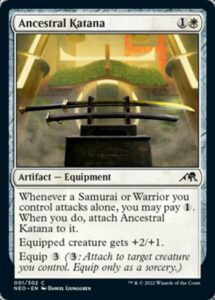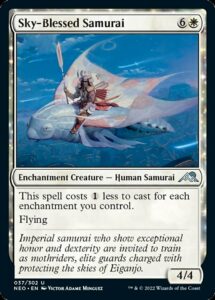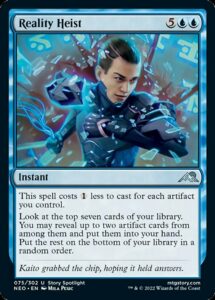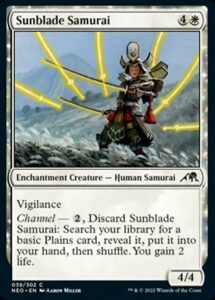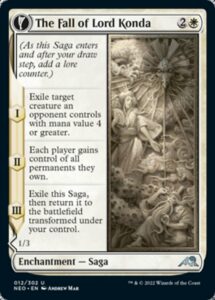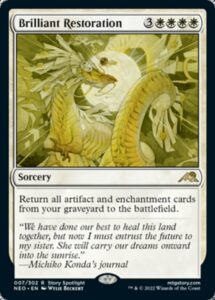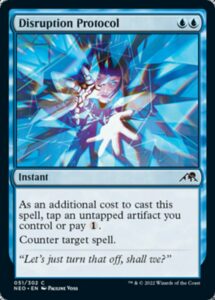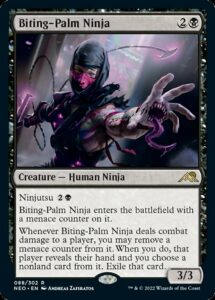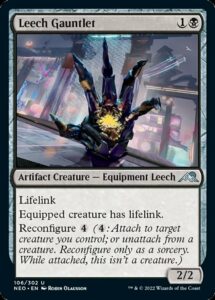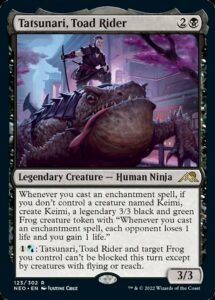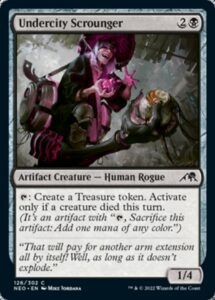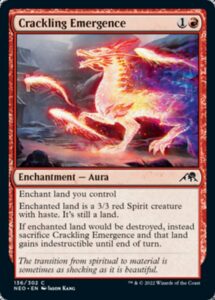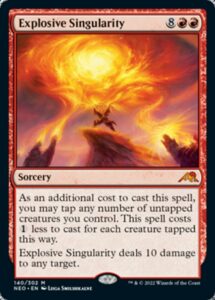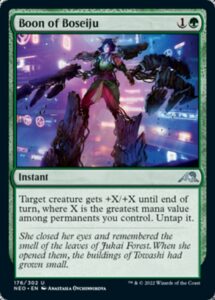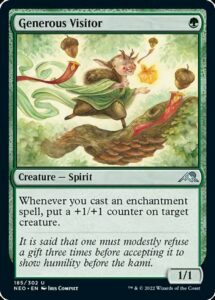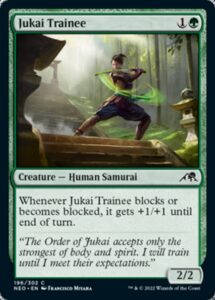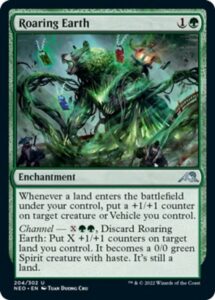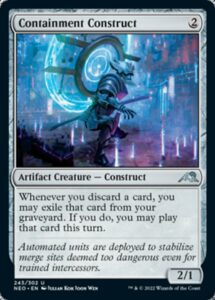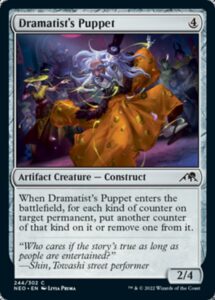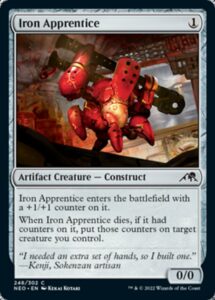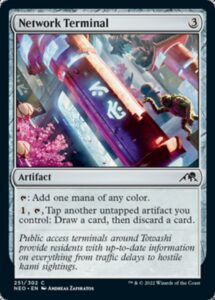I love Magic’s mechanics. This will likely come as no surprise to readers of this column (we just finished a review of all of last year’s new Standard mechanics). It’s fun diving into the history behind and innovation of all of Magic’s new mechanics. But Magic does far more than feature a small number of new and returning mechanics each set—every set takes the opportunity to reintroduce little callbacks to mechanics past. These can take the form of effective reprints where everything but the keyword is printing on the card, to subtle little tweaks that can help a single card fit better into a cohesive whole.
Kamigawa: Neon Dynasty seems unusually full of these mechanical echoes; so today, we’re going to take the opportunity to revisit a slew of old keywords, keyword actions, and ability words that have returned in some fashion. This will be a large list of mechanical callbacks, but not an exhaustive list of design references. For example, we could write an entire article about Born to Drive, a design that is both innovative and a descendant of Crusader of Odric, Raise the Alarm, and Alpha’s own Keldon Warlord. But if we were to be that granular, we’d be discussing every single card in the set, since everything has precedent in Magic’s massive past. We’ll try to focus mostly on named mechanics, but a couple cool individual callbacks have snuck their way in.
Exalted Samurai
The new Samurai mechanic is to Exalted what Magecraft was to Prowess. Instead of functioning the same way every time, every Samurai card provides a different Exalted bonus. This variety of output adds both power and complexity. However, unlike Exalted, this bonus is only bestowed on lone Samurai (rather than any solitary attacking creature). This likely helps moderate some of the mechanic’s complexity and power, since you likely have a more finite supply of samurai than creatures and are liable to lose bonuses as your attacking samurai fall in battle.
An affinity for Affinity
When introduced in 2003’s Mirrodin, Affinity proved far too strong. This was due to three factors:
- Affinity for Artifacts is really, really easy to enable in an artifact-focused Standard.
- Artifacts all being colorless makes it facile to fill your deck with them.
- Mirrodin included five artifact lands. You could effectively play twenty copies of Ancient Tomb with no downside.
When this broken context is removed, it turns out that cards like Gearseeker Serpent and Brine Giant are surprisingly safe to print. We’ll see whether Treasure Vault proves too much with Reality Heist, but it’s nice seeing Affinity do a cameo appearance when it’s so incredibly unlikely to ever be a featured mechanic again.
Very Basic Landcycling
Channel is like Kicker—it’s an overly broad mechanic. Mechanics like split cards, Cycling, and Evoke are very close to subsets of Channel. Wizards rightfully tends to avoid such mechanics, since they make it much so harder to create new keywords that feel novel. But, Channel is one of the few mechanics from Champions of Kamigawa block that could return, so it finally gets to reappear. And it works especially well as both a smoothing mechanic and a spell-like mechanic in a set that needs a high density of enchantments, vehicles, and equipment to support its themes.
Here, we’ve got an excellent example of how overly broad Channel can be. This is Noble Templar, except instead of being able to grab a Mistveil Plains or Sacred Foundry, it gives you two life.
A very on-Brand card
Brand is a weird effect. It’s scarcely used, though it’s become much more common effect as a failsafe in Commander. It makes more sense to me as a white effect than a red one, and it’s probably a sufficiently narrow effect that only one color needs to have it (in addition to colorless cards like Homeward Path). I just can’t get over how weird it makes The Fall of Lord Konda read as a design. It makes total sense as a retelling of Kamigawa’s story, though it may well be one of the least impactful chapters of any Saga thus far. But that’s the issue with Brands—most of the time, they don’t do anything and need to be tacked onto something as a secondary effect.
The specific callback
Many of the design discussed today are inheritors of entire mechanics. Sometimes, those mechanics were innovated on a single card and then blown out into mechanics, so we can point to a specific ancestral design. Here, Brilliant Restoration refers to a specific design whose effect is so dramatic that it simply can’t be done often: Replenish.
Replenish is an amazing effect for combo decks and Commander decks, but it is doomed to only become more expensive with time thanks to being on the Reserved List. We’ve seen a few echoes of it in cards like Open the Vaults, Calix, Destiny’s Hand, Resurgent Belief, and Triumphant Reckoning, but never a simple, straightforward repeat. The Reserved List prevents a functional reprint at the same cost, so it makes sense to print a version that’s more broad and less likely to break Modern while still giving people access to it in Commander.
Improvised Countermagic
This is almost exactly how Improvise works. It’s a little funny including this alongside Realist Heist given that Improvise is a weaker version of Affinity for Artifacts. Still, I like this as the set’s Cancel with upside as well as a callback to Stoic Rebuttal.
Counting counters without cutouts
I’m not sure how to think about ability counters. Ikoria: Lair of Behemoths introduced them and the punch-out counters used to track them, but that was at the height of the pandemic and I never had a chance to play with them in person. Mechanically, I like this innovation where the counter is a dual-use charge counter that enables a single saboteur effect. That said, given Kamigawa’s seemingly high complexity and definite focus on +1/+1 counters, I’m worried how it’ll actually feel playing with these—especially since there won’t be any physical keyword counters to use.
Living, breathing weapons
Equipment are problematic in two different ways:
- When you don’t have enough creatures, they do nothing.
- When you do have enough creatures, your opponent is usually helpless against them.
Back in 2012, Mirrodin Besieged introduced Living Weapon to deal with problem #1. Effectively you had little creatures that left behind an equipment when they died.
Reconfigure is a cool twist on Living Weapon. Instead of all of the power being built into the equipment itself (and the equipment having to give at least +0/+1 to enable a Germ to survive), it can be far more flexible in effect, from sharing keywords, to giving power and toughness bonuses, to granting entirely unrelated abilities (see The Reality Chip). This design also address problem #2, where suddenly the equipment itself is vulnerable to creature removal. It makes the mechanic weaker, but it may also make it play much better.
Fake Flying
I’ll be honest—I never expected to see another Spire Tracer. It’s Flying in all but name. Obviously, I’m very happy seeing any mechanic return in an unnamed form, but that’s because the set can’t contain the keyword itself. Every set has Flying. I get that this card wants the off-color hybrid effect for Commander and Flying is a better keyword to give away than Hexproof and that Ward wouldn’t work for this ability, but it’s still messy. Especially when this card is wordier than Valentin, Dean of the Vein and has almost as much nested text. Just say it gives the creatures flying already.
Morbid Boons
I love Morbid. I love what it did for original Innistrad. And I love it here as a one-off card in a set that doesn’t have a full-on artistocrats archetype. (BR sacrifice is about artifacts dying, not necessarily artifact creatures.)
Zendikenju
Betrayers of Kamigawa introduced a cycle of cards like Genju of the Spires. These were powerful and problematic due to their recursive play patterns—they made the things happen over and over again. Worldwake innovated on this design where you instead got the land back instead of the creature. This made perfect sense in a world with both Landfall and lands with enters-the-battlefield effects.
Here, we see a continuation of this design vein. It eschews the repetitive play patterns of the Genju, but lacking the Landfall support of the Zendikons, it just gives you your land back when it would otherwise die. It’s nice and simple, which I appreciate.
Hidetsugu’s Convocation
Convoke is one of Magic’s safest cost reduction mechanics. It comes every several years, so we rarely see it when it’s not keyworded. I’m happy seeing it return on this combo piece with Hidetsugu’s Second Rite. The only qualm I have is that with Affinity for Artifacts, Affinity for Enchantments, and Improvise, the set has four cost reduction mechanics that all work differently but read similarly.
Scourge’s Bonus
Scourge was a weird set. It ostensibly had a dragon theme, but it was more focused on mana value-matters. (And it introduced Storm, but there are no Storm callbacks here.) Mana value-matters works well on a combat trick like this. It naturally scales up over time and does so in a very green way. It’s aspirational in that it can become something akin to Berserk, but only if you’re playing with big mana cards.
The issue I have with this one-off mechanic is that it’s rather disconnected from everything else in the set. Sure, it’s a little weird having Improvise and Affinity for Artifacts alongside each other, but both signpost a heavily-support artifact theme. I’m not sure what, if anything, this intersects with. That’s not a problem in a low complexity set, but it can be dangerous for less enfranchised drafters to be presented with themes that aren’t supported. (That was one of my biggest issues with Dominaria—I saw several players draft Goblin Warchief early and be thwarted by the set’s almost complete lack of goblins that worked with it.)
Almost Constellation
Here, I have far fewer issues. Enchantments are a major theme of the set and Generous Visitor plays right into them.
Chub Toad, Chub Toad at the door
Continuing our conversation about Boon of Boseiju, I have no issues with this homage to Bushido. This at most suggests a mechanic of “combat matters,” a statement true of every Limited format and one that’s unlikely to lead a player astray.
I appreciate that Bushido is only a reference in Neon Dynasty rather than a feature mechanic. At high volume, it does nothing. At low volume, it makes combat math harder and disincentives both blocking and attacking.
Landfall is an excellent mechanic
Landfall returns unnamed on at least one card a year. It does this because it’s one of Magic’s best mechanics ever. Rewarding players for doing what’s good for them is a great game design practice that’s too easy to overlook in favor of encouraging the player to do things they don’t want to do.
Combo Madness
I don’t think I’d ever have expected Wizards to print a card that says “all of your cards have Madness, ever your lands.” Certainly not in a Standard-legal set. But, I’d have been wrong. This card seems absolutely bonkers in combo decks and fun in Cube. I’m pretty excited about this one.
A light proliferation of Proliferation
This is a return of Proliferate Lite seen on Maulfist Revolutionary, but with a twist. Now, you can remove modifications as well! That makes perfect sense in a set that’s about getting bonuses from a single counter rather than magnifying a single counter into many more counters.
More modular Modular
Modular keeps returning in small volume, and tends to become more flexible with time. Servant of the Scale gives its +1/+1 counters to anything, not just artifacts. Parish-Blade Trainee gives away all counters, not just +1/+1 counters. Here, we’ve got a slight new innovation to make it more digital-friendly: now, it only puts a trigger on the stack if it has counters to give.
Perhaps the next card in this line will give you a “may” trigger. That’s an additional click for digital and only matters in a format with -1/-1 counters. Magic has soured on -1/-1 counters, but with a likely return to New Phyrexia in the next few years, perhaps we might just get this tweak after all?
More coherent Cohort
Our story ends today with one of Magic’s least loved mechanics. Cohort was the Ally mechanic in Oath of the Gatewatch (as on Malakir Soothsayer) and it was painfully restrictive. Here, we’ve got a far more open-ended twist that’s much harder to disrupt. It’s a good reminder that every mechanic, even one of Magic’s least popular, can have a place. Sure, you might not be able to rehabilitate it into a popular new mechanic, as Chroma enjoyed when it was turned into Devotion, but you might just be able to carve a new niche vein of design space that future sets can use.
That feels like a perfect spot to end today, by recognizing the promise and value of a mechanic most players might have forgotten and probably didn’t notice when looking at Network Terminal. There’s so much history and game design in every single Magic card. It’s both easy and right to glance past it and just enjoy playing with the new set. But for some of us, the appreciation of that game design is its own form of enjoyment. Hopefully this review was enjoyable for you, too. Perhaps you’ve noticed some of the callbacks we couldn’t get to in this article. Perhaps this might just get you to look for some of them, yourself.
And, as always, thanks for reading.
Zachary Barash is a New York City-based game designer and the commissioner of Team Draft League. He designs for Kingdom Death: Monster, has a Game Design MFA from the NYU Game Center, and does freelance game design. When the stars align, he streams Magic (but the stars align way less often than he’d like).

